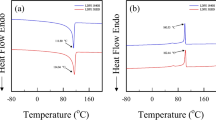Abstract
Thermal decomposition, thermal conductivity, specific heat and flammability of polydimethyl siloxane (PDMS) resin and three PDMS-based systems with three different types of additives were studied using various thermo-analytical techniques. The additives were found to modify the thermal properties of PDMS to different extents. Among the three systems, highest specific heat and lowest thermal conductivity, desired for thermal protection application, were obtained for System I. The thermal stability of the three systems is in the order System I > System II > System III. Even though System III showed the lowest specific heat and highest thermal conductivity, due to its very high LOI among all other systems, the system finds application as a flame retardant. Thermogravimetric–mass spectroscopic analysis was carried out to find out the decomposition products. The major decomposition product was identified as hexamethylcyclotrisiloxane in all the systems. The decomposition kinetics of these systems was investigated by thermogravimetry using multiple heating rate methods, viz. Kissinger and Flynn–Wall–Ozawa. The kinetic parameters, viz. activation energy and pre-exponential factor, were derived using the two methods for all the systems. From the kinetic study, it is confirmed that the activation energy for the decomposition of the neat PDMS decreased as decomposition progressed, whereas the activation energy increased for the silicone composite systems.









Similar content being viewed by others
References
Koo JH, Miller MJ, Weispfenning J, Blackmon C. Silicone polymer composites for thermal protection system: fiber reinforcements and microstructures. J Compos Mater. 2011. doi:10.1177/0021998310381536.
Robert OE. Polymer additives and reinforcements. New york: CRC Press; 2000 Chapter 9.
Przemysław R, Witold Z, Dariusz B. Influence of cenosphere particles on thermal properties composites of silicon rubber. J Therm Anal Calorim. 2015;122:1307–18. doi:10.1007/s10973-015-4829-0.
Przemysław R, Witold Z, Dariusz B. Effect of cenospheric fillers on the flammability and fire hazard of silicone rubber composites. J Therm Anal Calorim. 2016;125:1373–86. doi:10.1007/s10973-016-5741-y.
Hanu LG, Simon GP, Cheng YB. Thermal stability and flammability of silicone polymer composites. Polym Degrad Stab. 2006;91:1373–9.
Morales C, Möller M. Homopolymerization of poly(dimethyl siloxane) macromonomers via free radical polymerization. Rev Mexi de Ing Quím. 2007;6:219–28.
Marques MMP, Salvado IMM, Margaca FMA, Ferreira LM. The role of Zirconium as thermal stabilizer of PDMS–TEOS Hybrids. J Therm Anal Calorim. 2010;100:557–61. doi:10.1007/s10973-009-0180-7.
Bescher E, Hoshino Y, Nishizawa Y, Cooley K, Mackenzie JD. The role of Fe in the thermal stabilization of ormosils. J Sol–Gel Sci Tech. 2003;26:297–301.
Girish D, Mary ER. Kinetic aspects of the thermal degradation of polydimethyl siloxane and polydimethyl diphenyl siloxane. Polym Degrad Stab. 2002;76:17–24.
Kimberly C, Sam C, Adri CT, Van D, William AG, Edward MK. Simulations on the thermal decomposition of a poly(dimethyl siloxane) polymer using the ReaxFF reactive force field. J Am Chem Soc. 2005;127:7192–202.
Siska H, Claire L, Didier P, Jose´ ML, François G. Flame retardancy of silicone-based materials. Polym Degrad Stab. 2009;94:465–95.
Standard test method for determining specific heat capacity by differential scanning calorimetry. ASTM E 1269-11.
Standard test method for evaluating the resistance to thermal transmission of materials by the guarded heat flow meter technique. ASTM E 1530-11.
Standard test method for measuring the minimum oxygen concentration to support candle- like combustion of plastics. ASTM D 2863-13.
Li L, Jinlong Z, Xilei C, Chuanmei J, Shaoxiang L, Yuanxiang G. Influence of ferric hydroxide on smoke suppression properties and combustion behavior of intumescent flame retardant silicone rubber composites. J Therm Anal Calorim. 2015;119:487–97. doi:10.1007/s10973-014-4108-5.
Radhakrishnan TS. New method for evaluation of kinetic parameters and mechanism of degradation from pyrolysis-GC studies: thermal degradation of polydimethyl siloxanes. J Appl Polym Sci. 1999;73:441–50.
Camino G, Lomakin SM, Lazzari M. Polydimethyl siloxane thermal degradation, Part 1. Kinetic aspects. Polymer. 2001. doi:10.1016/S0032-3861(00)00652-2.
Thomas K, Kendrick TC. Thermal analysis of polydimethyl siloxanes, thermal degradation in controlled atmospheres. J Polym Sci Part A: Polym Chem. 1969;7:537–49.
Robert AR. Therm Stable Elastom A Rev. Ordnance Systems Department. 1983.
Bogatyr’ov VM, Borysenko MV. Thermal destruction of polydimethyl siloxane on a phosphorus-containing silica surface. J Therm Anal Calorim. 2000;62:335.
Jovicic MC, Radicevic RZ, Budinski SJK. Curing of alkyds based on semi-drying oils with melamine resin. J Therm Anal Calorim. 2008;94:143–50.
Supriya N, Bina KC, Rajeev R. DSC-TG studies on kinetics of curing and thermal decomposition of epoxy–ether amine systems. J Therm Anal Calorim. 2013. doi:10.1007/s10973-012-2805-5.
Vyazovkin S, Burnham AK, Criado JM. Perez-MLA, Popescu C, Sbirrazzuoli N. ICTAC Kinetics committee recommendations for performing kinetic computations on thermal analysis data. Thermochim Acta. 2011;520:1–19.
Kissinger HE. Reaction kinetics in differential thermal analysis. Anal Chem. 1957;29:1702–6.
Standard Test Method for Decomposition kinetics by Thermogravimetry using the Ozawa/Flynn/Wall Method, ASTM, E1641-13.
Author information
Authors and Affiliations
Corresponding author
Rights and permissions
About this article
Cite this article
Nair, S., Aswathy, U., Mathew, A. et al. Studies on the thermal properties of silicone polymer based thermal protection systems for space applications. J Therm Anal Calorim 128, 1731–1741 (2017). https://doi.org/10.1007/s10973-016-6025-2
Received:
Accepted:
Published:
Issue Date:
DOI: https://doi.org/10.1007/s10973-016-6025-2




